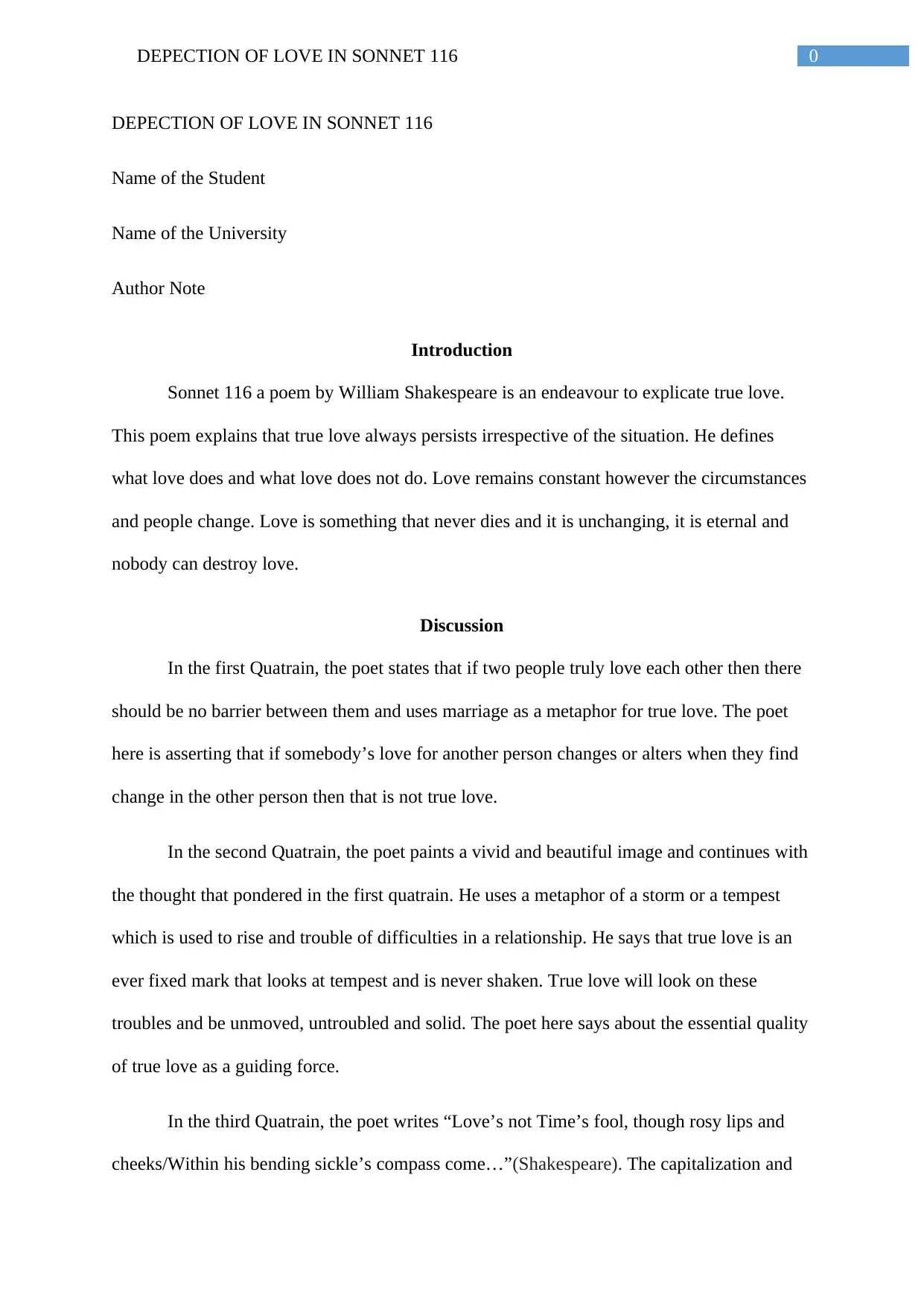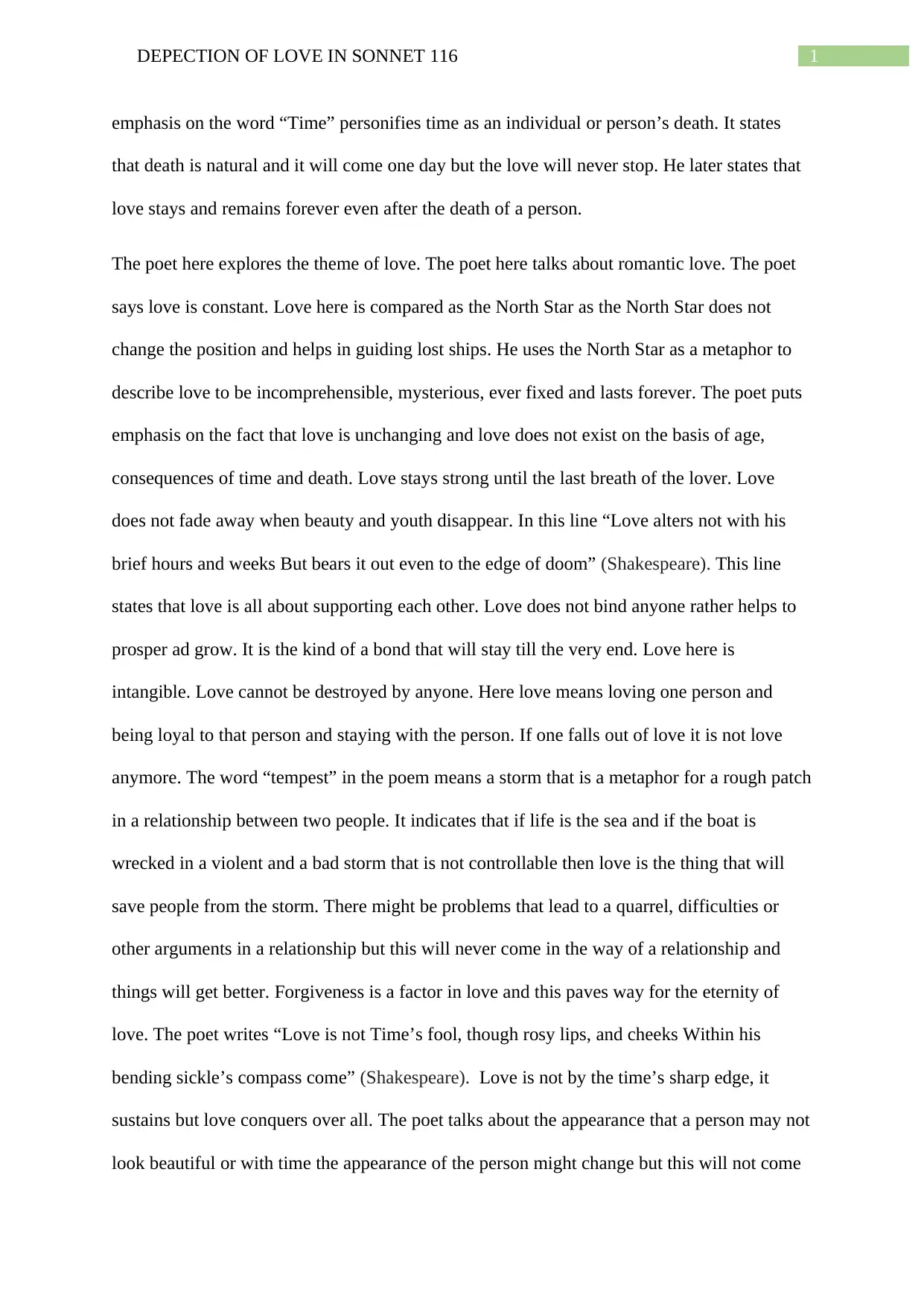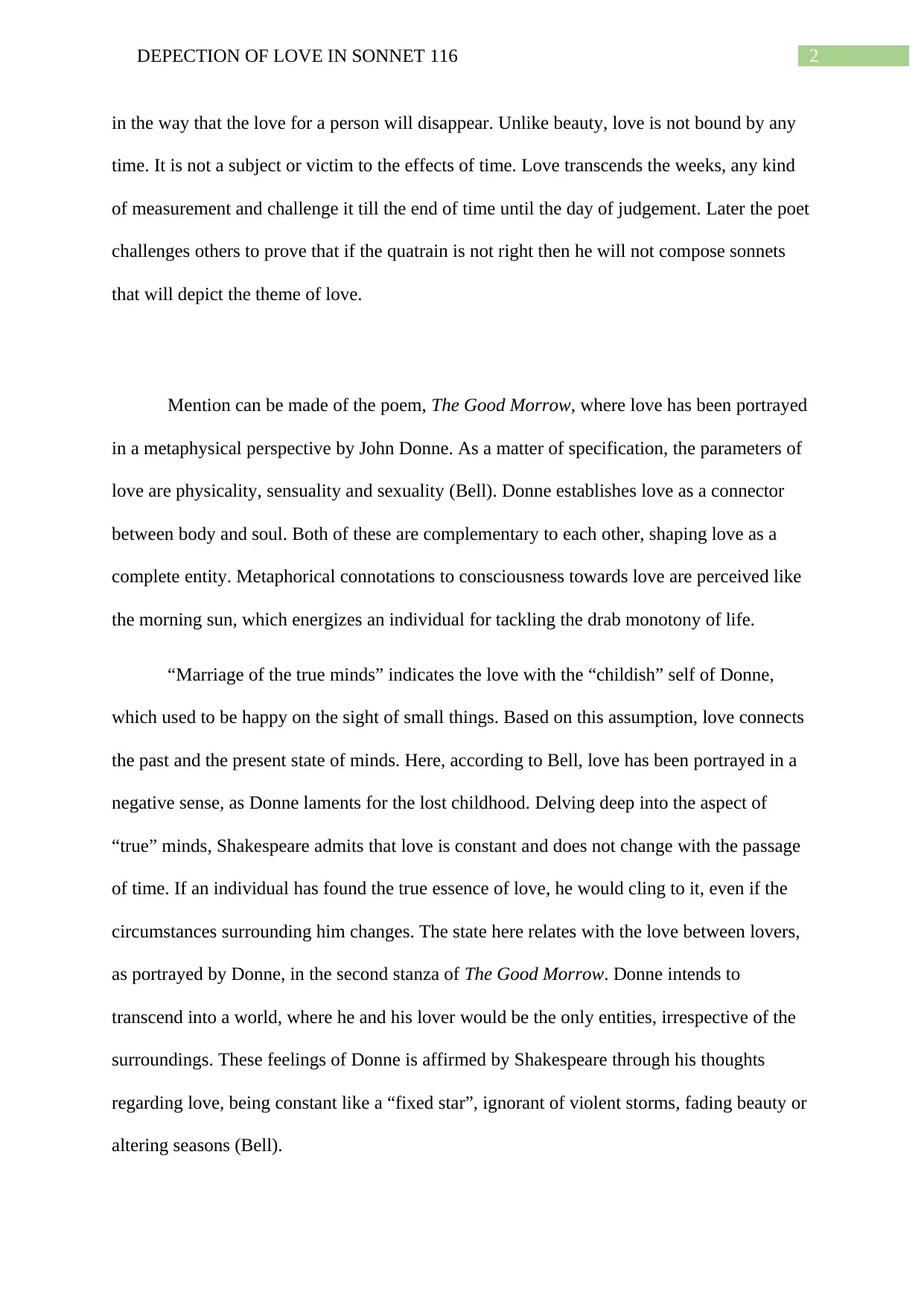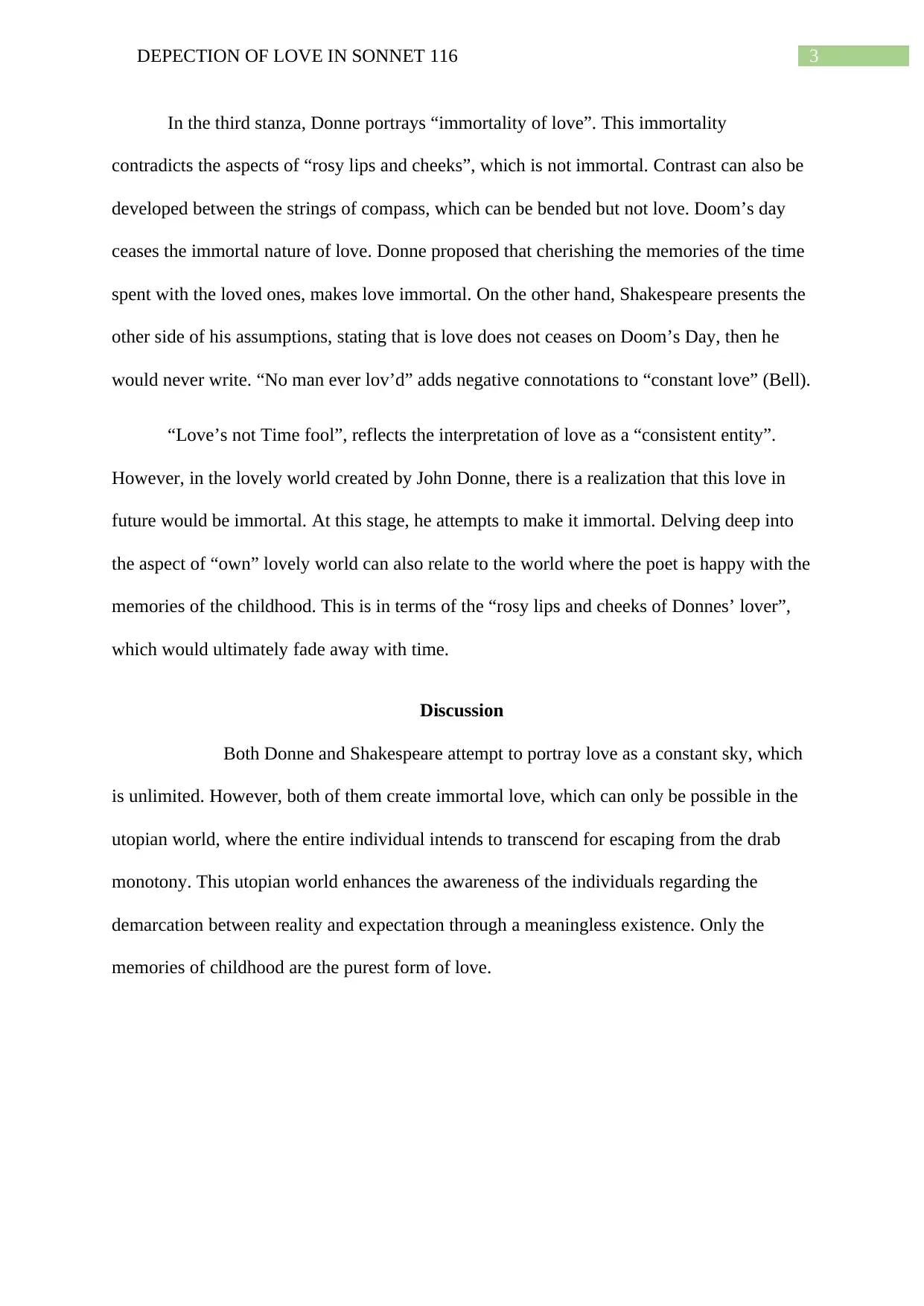Exploring the Theme of Love in Shakespeare's Sonnet 116: Analysis
VerifiedAdded on 2023/01/16
|5
|1563
|48
Essay
AI Summary
This essay provides an in-depth analysis of William Shakespeare's Sonnet 116, focusing on its depiction of true love. The essay examines the poem's central themes, including love's constancy, its resistance to change and time, and its eternal nature. It explores Shakespeare's use of metaphors, such as marriage and the North Star, to illustrate these concepts. The discussion further delves into how love transcends physical beauty, age, and even death. Additionally, the essay compares Shakespeare's portrayal of love with John Donne's perspectives in 'The Good Morrow', highlighting similarities and differences in their approaches. The analysis emphasizes the poem's enduring message about the unwavering and immutable essence of genuine love.

0DEPECTION OF LOVE IN SONNET 116
DEPECTION OF LOVE IN SONNET 116
Name of the Student
Name of the University
Author Note
Introduction
Sonnet 116 a poem by William Shakespeare is an endeavour to explicate true love.
This poem explains that true love always persists irrespective of the situation. He defines
what love does and what love does not do. Love remains constant however the circumstances
and people change. Love is something that never dies and it is unchanging, it is eternal and
nobody can destroy love.
Discussion
In the first Quatrain, the poet states that if two people truly love each other then there
should be no barrier between them and uses marriage as a metaphor for true love. The poet
here is asserting that if somebody’s love for another person changes or alters when they find
change in the other person then that is not true love.
In the second Quatrain, the poet paints a vivid and beautiful image and continues with
the thought that pondered in the first quatrain. He uses a metaphor of a storm or a tempest
which is used to rise and trouble of difficulties in a relationship. He says that true love is an
ever fixed mark that looks at tempest and is never shaken. True love will look on these
troubles and be unmoved, untroubled and solid. The poet here says about the essential quality
of true love as a guiding force.
In the third Quatrain, the poet writes “Love’s not Time’s fool, though rosy lips and
cheeks/Within his bending sickle’s compass come…”(Shakespeare). The capitalization and
DEPECTION OF LOVE IN SONNET 116
Name of the Student
Name of the University
Author Note
Introduction
Sonnet 116 a poem by William Shakespeare is an endeavour to explicate true love.
This poem explains that true love always persists irrespective of the situation. He defines
what love does and what love does not do. Love remains constant however the circumstances
and people change. Love is something that never dies and it is unchanging, it is eternal and
nobody can destroy love.
Discussion
In the first Quatrain, the poet states that if two people truly love each other then there
should be no barrier between them and uses marriage as a metaphor for true love. The poet
here is asserting that if somebody’s love for another person changes or alters when they find
change in the other person then that is not true love.
In the second Quatrain, the poet paints a vivid and beautiful image and continues with
the thought that pondered in the first quatrain. He uses a metaphor of a storm or a tempest
which is used to rise and trouble of difficulties in a relationship. He says that true love is an
ever fixed mark that looks at tempest and is never shaken. True love will look on these
troubles and be unmoved, untroubled and solid. The poet here says about the essential quality
of true love as a guiding force.
In the third Quatrain, the poet writes “Love’s not Time’s fool, though rosy lips and
cheeks/Within his bending sickle’s compass come…”(Shakespeare). The capitalization and
Paraphrase This Document
Need a fresh take? Get an instant paraphrase of this document with our AI Paraphraser

1DEPECTION OF LOVE IN SONNET 116
emphasis on the word “Time” personifies time as an individual or person’s death. It states
that death is natural and it will come one day but the love will never stop. He later states that
love stays and remains forever even after the death of a person.
The poet here explores the theme of love. The poet here talks about romantic love. The poet
says love is constant. Love here is compared as the North Star as the North Star does not
change the position and helps in guiding lost ships. He uses the North Star as a metaphor to
describe love to be incomprehensible, mysterious, ever fixed and lasts forever. The poet puts
emphasis on the fact that love is unchanging and love does not exist on the basis of age,
consequences of time and death. Love stays strong until the last breath of the lover. Love
does not fade away when beauty and youth disappear. In this line “Love alters not with his
brief hours and weeks But bears it out even to the edge of doom” (Shakespeare). This line
states that love is all about supporting each other. Love does not bind anyone rather helps to
prosper ad grow. It is the kind of a bond that will stay till the very end. Love here is
intangible. Love cannot be destroyed by anyone. Here love means loving one person and
being loyal to that person and staying with the person. If one falls out of love it is not love
anymore. The word “tempest” in the poem means a storm that is a metaphor for a rough patch
in a relationship between two people. It indicates that if life is the sea and if the boat is
wrecked in a violent and a bad storm that is not controllable then love is the thing that will
save people from the storm. There might be problems that lead to a quarrel, difficulties or
other arguments in a relationship but this will never come in the way of a relationship and
things will get better. Forgiveness is a factor in love and this paves way for the eternity of
love. The poet writes “Love is not Time’s fool, though rosy lips, and cheeks Within his
bending sickle’s compass come” (Shakespeare). Love is not by the time’s sharp edge, it
sustains but love conquers over all. The poet talks about the appearance that a person may not
look beautiful or with time the appearance of the person might change but this will not come
emphasis on the word “Time” personifies time as an individual or person’s death. It states
that death is natural and it will come one day but the love will never stop. He later states that
love stays and remains forever even after the death of a person.
The poet here explores the theme of love. The poet here talks about romantic love. The poet
says love is constant. Love here is compared as the North Star as the North Star does not
change the position and helps in guiding lost ships. He uses the North Star as a metaphor to
describe love to be incomprehensible, mysterious, ever fixed and lasts forever. The poet puts
emphasis on the fact that love is unchanging and love does not exist on the basis of age,
consequences of time and death. Love stays strong until the last breath of the lover. Love
does not fade away when beauty and youth disappear. In this line “Love alters not with his
brief hours and weeks But bears it out even to the edge of doom” (Shakespeare). This line
states that love is all about supporting each other. Love does not bind anyone rather helps to
prosper ad grow. It is the kind of a bond that will stay till the very end. Love here is
intangible. Love cannot be destroyed by anyone. Here love means loving one person and
being loyal to that person and staying with the person. If one falls out of love it is not love
anymore. The word “tempest” in the poem means a storm that is a metaphor for a rough patch
in a relationship between two people. It indicates that if life is the sea and if the boat is
wrecked in a violent and a bad storm that is not controllable then love is the thing that will
save people from the storm. There might be problems that lead to a quarrel, difficulties or
other arguments in a relationship but this will never come in the way of a relationship and
things will get better. Forgiveness is a factor in love and this paves way for the eternity of
love. The poet writes “Love is not Time’s fool, though rosy lips, and cheeks Within his
bending sickle’s compass come” (Shakespeare). Love is not by the time’s sharp edge, it
sustains but love conquers over all. The poet talks about the appearance that a person may not
look beautiful or with time the appearance of the person might change but this will not come

2DEPECTION OF LOVE IN SONNET 116
in the way that the love for a person will disappear. Unlike beauty, love is not bound by any
time. It is not a subject or victim to the effects of time. Love transcends the weeks, any kind
of measurement and challenge it till the end of time until the day of judgement. Later the poet
challenges others to prove that if the quatrain is not right then he will not compose sonnets
that will depict the theme of love.
Mention can be made of the poem, The Good Morrow, where love has been portrayed
in a metaphysical perspective by John Donne. As a matter of specification, the parameters of
love are physicality, sensuality and sexuality (Bell). Donne establishes love as a connector
between body and soul. Both of these are complementary to each other, shaping love as a
complete entity. Metaphorical connotations to consciousness towards love are perceived like
the morning sun, which energizes an individual for tackling the drab monotony of life.
“Marriage of the true minds” indicates the love with the “childish” self of Donne,
which used to be happy on the sight of small things. Based on this assumption, love connects
the past and the present state of minds. Here, according to Bell, love has been portrayed in a
negative sense, as Donne laments for the lost childhood. Delving deep into the aspect of
“true” minds, Shakespeare admits that love is constant and does not change with the passage
of time. If an individual has found the true essence of love, he would cling to it, even if the
circumstances surrounding him changes. The state here relates with the love between lovers,
as portrayed by Donne, in the second stanza of The Good Morrow. Donne intends to
transcend into a world, where he and his lover would be the only entities, irrespective of the
surroundings. These feelings of Donne is affirmed by Shakespeare through his thoughts
regarding love, being constant like a “fixed star”, ignorant of violent storms, fading beauty or
altering seasons (Bell).
in the way that the love for a person will disappear. Unlike beauty, love is not bound by any
time. It is not a subject or victim to the effects of time. Love transcends the weeks, any kind
of measurement and challenge it till the end of time until the day of judgement. Later the poet
challenges others to prove that if the quatrain is not right then he will not compose sonnets
that will depict the theme of love.
Mention can be made of the poem, The Good Morrow, where love has been portrayed
in a metaphysical perspective by John Donne. As a matter of specification, the parameters of
love are physicality, sensuality and sexuality (Bell). Donne establishes love as a connector
between body and soul. Both of these are complementary to each other, shaping love as a
complete entity. Metaphorical connotations to consciousness towards love are perceived like
the morning sun, which energizes an individual for tackling the drab monotony of life.
“Marriage of the true minds” indicates the love with the “childish” self of Donne,
which used to be happy on the sight of small things. Based on this assumption, love connects
the past and the present state of minds. Here, according to Bell, love has been portrayed in a
negative sense, as Donne laments for the lost childhood. Delving deep into the aspect of
“true” minds, Shakespeare admits that love is constant and does not change with the passage
of time. If an individual has found the true essence of love, he would cling to it, even if the
circumstances surrounding him changes. The state here relates with the love between lovers,
as portrayed by Donne, in the second stanza of The Good Morrow. Donne intends to
transcend into a world, where he and his lover would be the only entities, irrespective of the
surroundings. These feelings of Donne is affirmed by Shakespeare through his thoughts
regarding love, being constant like a “fixed star”, ignorant of violent storms, fading beauty or
altering seasons (Bell).
⊘ This is a preview!⊘
Do you want full access?
Subscribe today to unlock all pages.

Trusted by 1+ million students worldwide

3DEPECTION OF LOVE IN SONNET 116
In the third stanza, Donne portrays “immortality of love”. This immortality
contradicts the aspects of “rosy lips and cheeks”, which is not immortal. Contrast can also be
developed between the strings of compass, which can be bended but not love. Doom’s day
ceases the immortal nature of love. Donne proposed that cherishing the memories of the time
spent with the loved ones, makes love immortal. On the other hand, Shakespeare presents the
other side of his assumptions, stating that is love does not ceases on Doom’s Day, then he
would never write. “No man ever lov’d” adds negative connotations to “constant love” (Bell).
“Love’s not Time fool”, reflects the interpretation of love as a “consistent entity”.
However, in the lovely world created by John Donne, there is a realization that this love in
future would be immortal. At this stage, he attempts to make it immortal. Delving deep into
the aspect of “own” lovely world can also relate to the world where the poet is happy with the
memories of the childhood. This is in terms of the “rosy lips and cheeks of Donnes’ lover”,
which would ultimately fade away with time.
Discussion
Both Donne and Shakespeare attempt to portray love as a constant sky, which
is unlimited. However, both of them create immortal love, which can only be possible in the
utopian world, where the entire individual intends to transcend for escaping from the drab
monotony. This utopian world enhances the awareness of the individuals regarding the
demarcation between reality and expectation through a meaningless existence. Only the
memories of childhood are the purest form of love.
In the third stanza, Donne portrays “immortality of love”. This immortality
contradicts the aspects of “rosy lips and cheeks”, which is not immortal. Contrast can also be
developed between the strings of compass, which can be bended but not love. Doom’s day
ceases the immortal nature of love. Donne proposed that cherishing the memories of the time
spent with the loved ones, makes love immortal. On the other hand, Shakespeare presents the
other side of his assumptions, stating that is love does not ceases on Doom’s Day, then he
would never write. “No man ever lov’d” adds negative connotations to “constant love” (Bell).
“Love’s not Time fool”, reflects the interpretation of love as a “consistent entity”.
However, in the lovely world created by John Donne, there is a realization that this love in
future would be immortal. At this stage, he attempts to make it immortal. Delving deep into
the aspect of “own” lovely world can also relate to the world where the poet is happy with the
memories of the childhood. This is in terms of the “rosy lips and cheeks of Donnes’ lover”,
which would ultimately fade away with time.
Discussion
Both Donne and Shakespeare attempt to portray love as a constant sky, which
is unlimited. However, both of them create immortal love, which can only be possible in the
utopian world, where the entire individual intends to transcend for escaping from the drab
monotony. This utopian world enhances the awareness of the individuals regarding the
demarcation between reality and expectation through a meaningless existence. Only the
memories of childhood are the purest form of love.
Paraphrase This Document
Need a fresh take? Get an instant paraphrase of this document with our AI Paraphraser

4DEPECTION OF LOVE IN SONNET 116
References
Bell, Gregory Stuart. John Donne: Love and Voices in the Elegies and Songs and Sonnets.
MS thesis. University of Sydney, 2015.
Shakespeare, W. (2004). Sonnet# 116. Project Gutenberg.
References
Bell, Gregory Stuart. John Donne: Love and Voices in the Elegies and Songs and Sonnets.
MS thesis. University of Sydney, 2015.
Shakespeare, W. (2004). Sonnet# 116. Project Gutenberg.
1 out of 5
Your All-in-One AI-Powered Toolkit for Academic Success.
+13062052269
info@desklib.com
Available 24*7 on WhatsApp / Email
![[object Object]](/_next/static/media/star-bottom.7253800d.svg)
Unlock your academic potential
Copyright © 2020–2025 A2Z Services. All Rights Reserved. Developed and managed by ZUCOL.